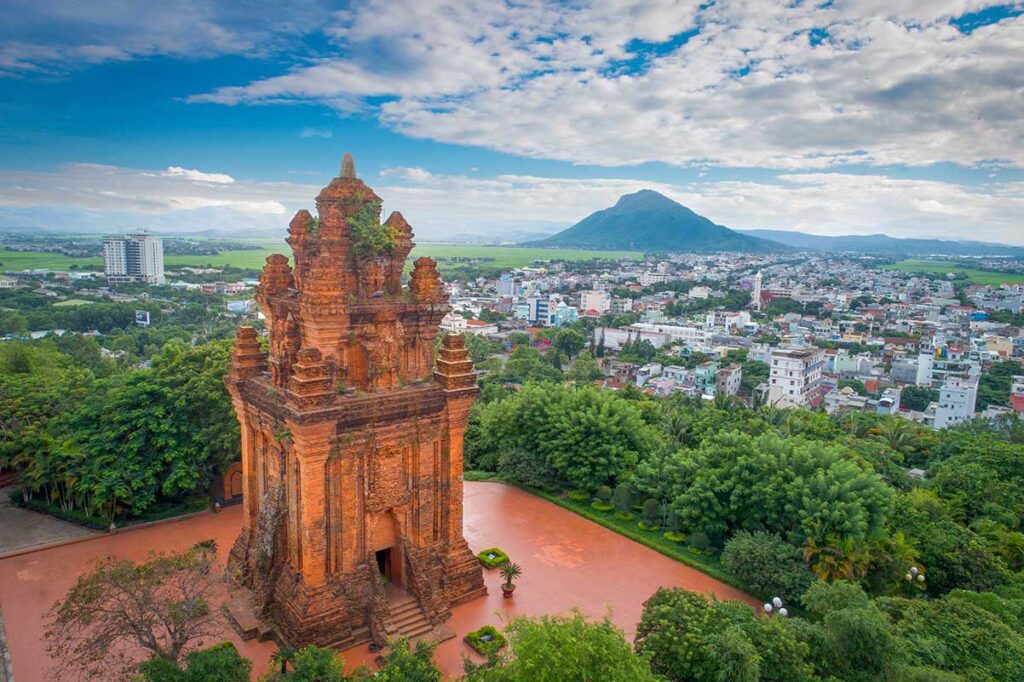Nhan Tower – Cham landmark in Tuy Hoa
Rising above Tuy Hoa on Nhan Mountain, Nhan Tower looks out over the Da Rang River and the fast-growing city below. The contrast between the ancient Cham brickwork and the modern streets surrounding it is striking, and it’s this mix of history and setting that makes the site memorable. Today, the tower is considered one of the most intact Cham structures in Vietnam and stands as a proud cultural symbol of Phu Yen.
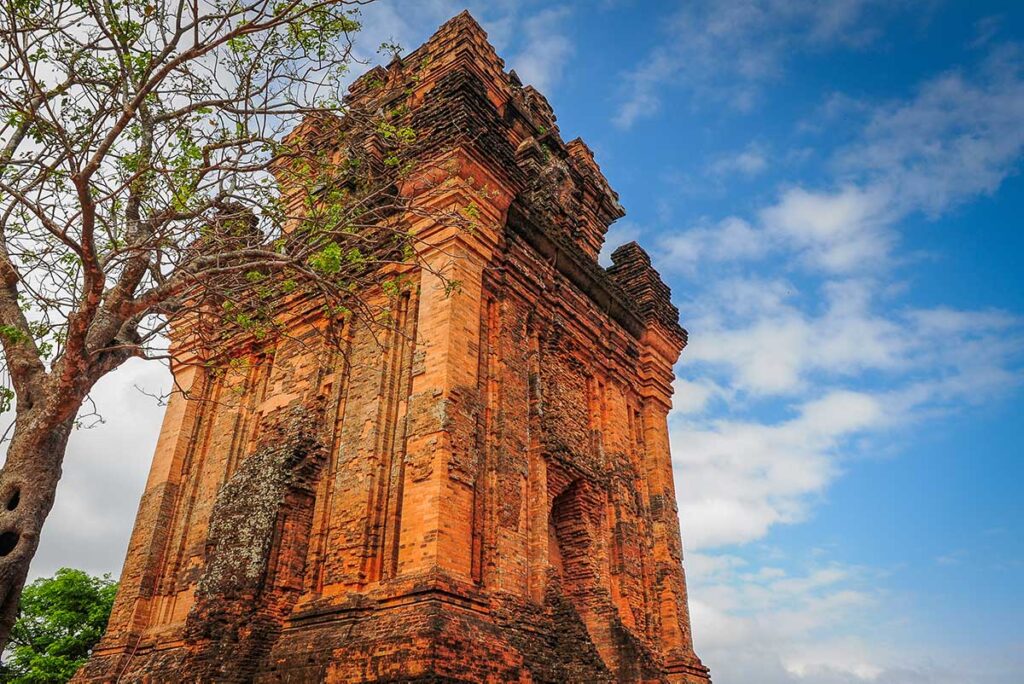
History & Cultural Significance
Nhan Tower was built in the late 11th to early 12th century, at a time when Cham architecture was shifting between the earlier My Son A1 style and the later Binh Dinh style. Like other Cham towers, it served as a Hindu place of worship, with the stone linga at the top symbolizing Shiva and fertility.
The tower went through long periods of decline and damage, including during colonial times and the French wars, before being restored under the regime of Ngo Dinh Diem in the 1960s. In recognition of its value, it was listed as a national relic in 1998 and upgraded to a special national relic in 2018. Beyond its spiritual and cultural importance, the hill itself also played a role in modern history, serving as a strategic military position thanks to its commanding views.
Legends & Symbolism
Local stories tie the tower to the goddess Thien Y A Na, who is said to have taught the Cham people weaving and farming before returning to heaven, after which the tower was built in her honor. The name “Nhan” is often linked to the swallows that once nested in the tower, or to the mountain’s swallow-like shape when seen from afar.

Symbolically, the architecture reflects the Cham vision of the universe: the square base represents the earth, the tower’s body stands for humanity, and the tapering roof with its linga points toward heaven and fertility. In some ethnic languages of the region, such as Ede and Jarai, the tower is also known as Yang Ko Hmeng, showing its place in broader highland traditions.
Highlights of visiting Nhan Tower
A visit to Nhan Tower is usually a short stop of about 30 to 60 minutes. It’s not a large complex, but the combination of Cham history, city views, and quiet atmosphere makes it worthwhile. You’ll find mostly domestic visitors here, so the site feels less touristy than other Cham monuments in Vietnam.
1. Walking up Nhan Mountain
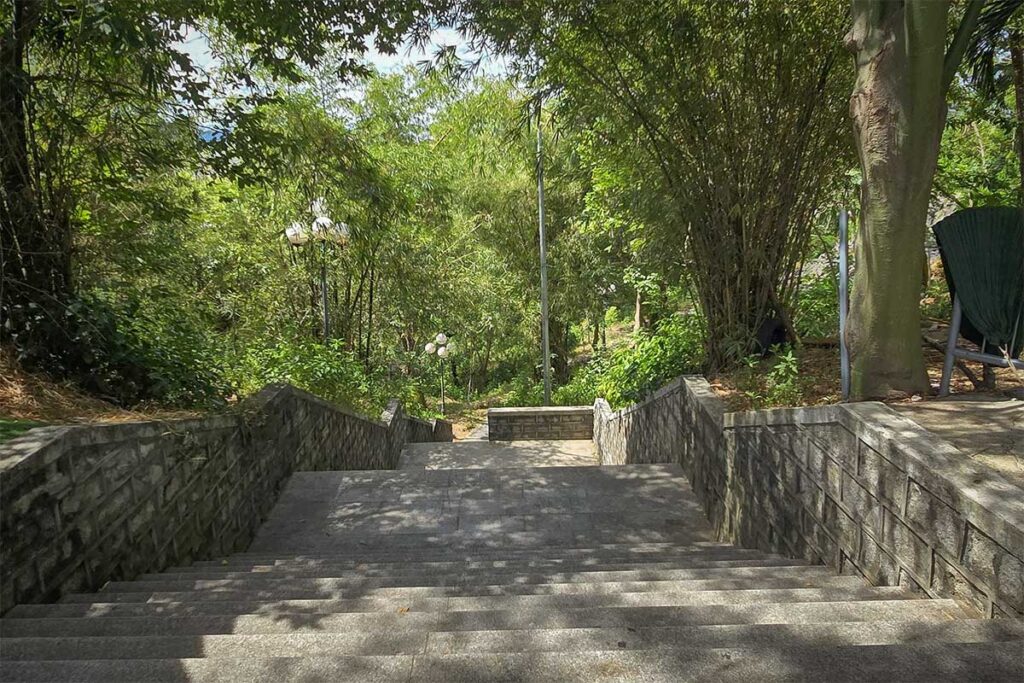
To reach the tower, you can either take a staircase directly up the hill or follow a paved road that winds more gently to the top. The climb itself is short—around five to ten minutes—and easy to manage for most visitors. If you prefer not to walk, an electric cart runs up and down the hill for a small fee of about 15,000 VND.
2. Scenic views from the hilltop

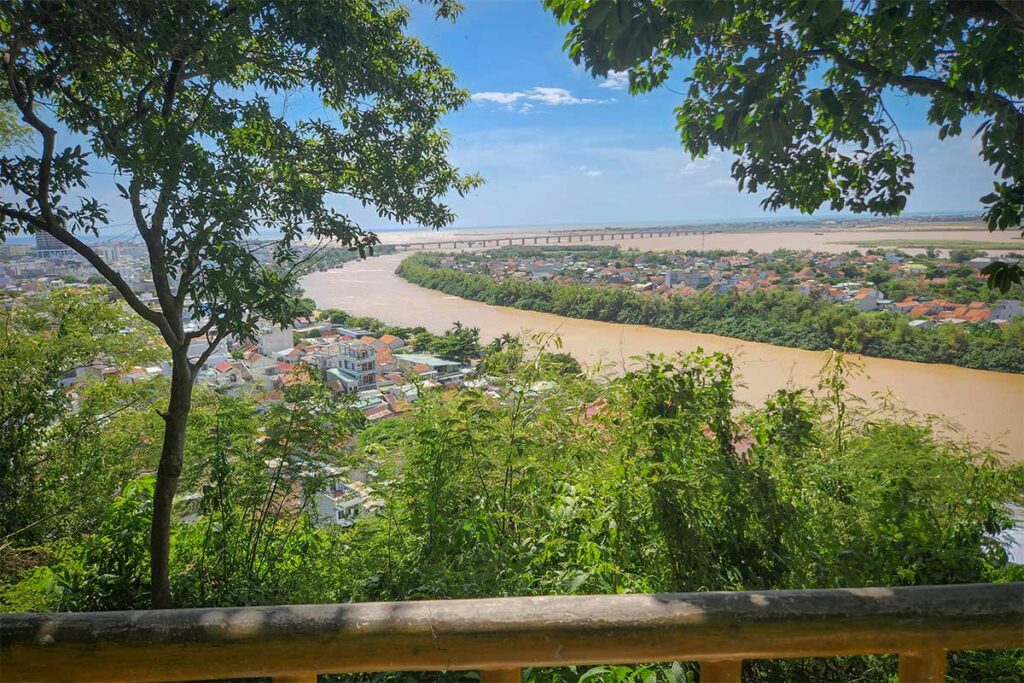
From the top, you get wide views across Tuy Hoa city, the Da Rang River, and the coastline stretching toward the horizon. The Hùng Vương Bridge is visible below, and on clear days you can see far along the flat coastal plains. Sunrise and sunset are the best times to take in the view, with softer light and cooler air.
3. Cham architecture & Brickwork

The tower itself rises about 20–25 meters high with a square base roughly 10–11 meters on each side. Its four levels taper upward in the Cham style, built with bricks laid so precisely that mortar was not needed.
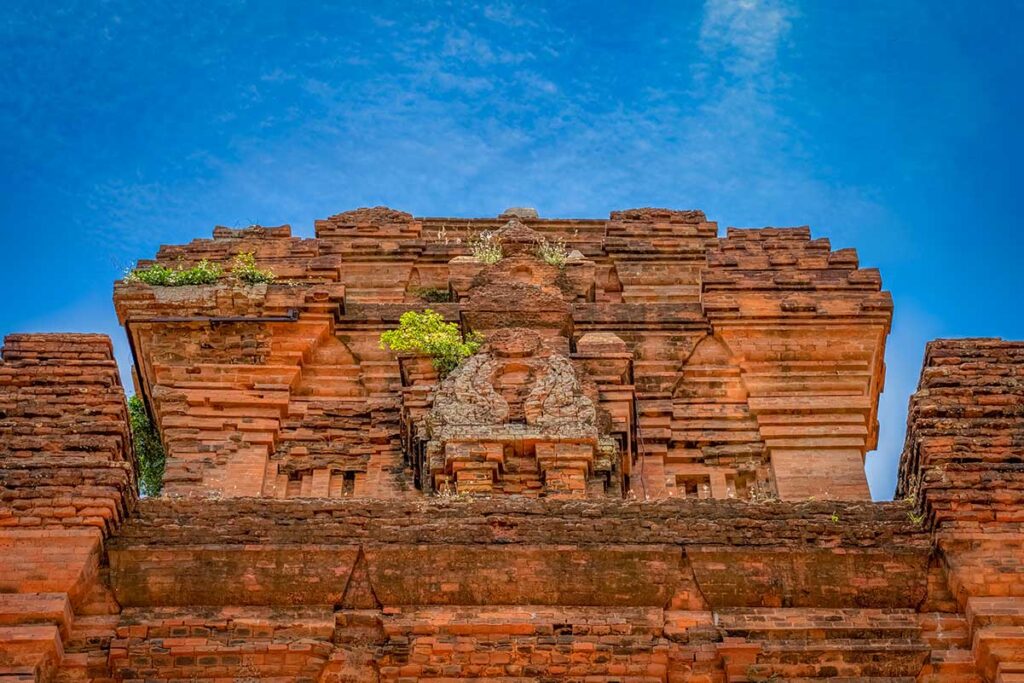
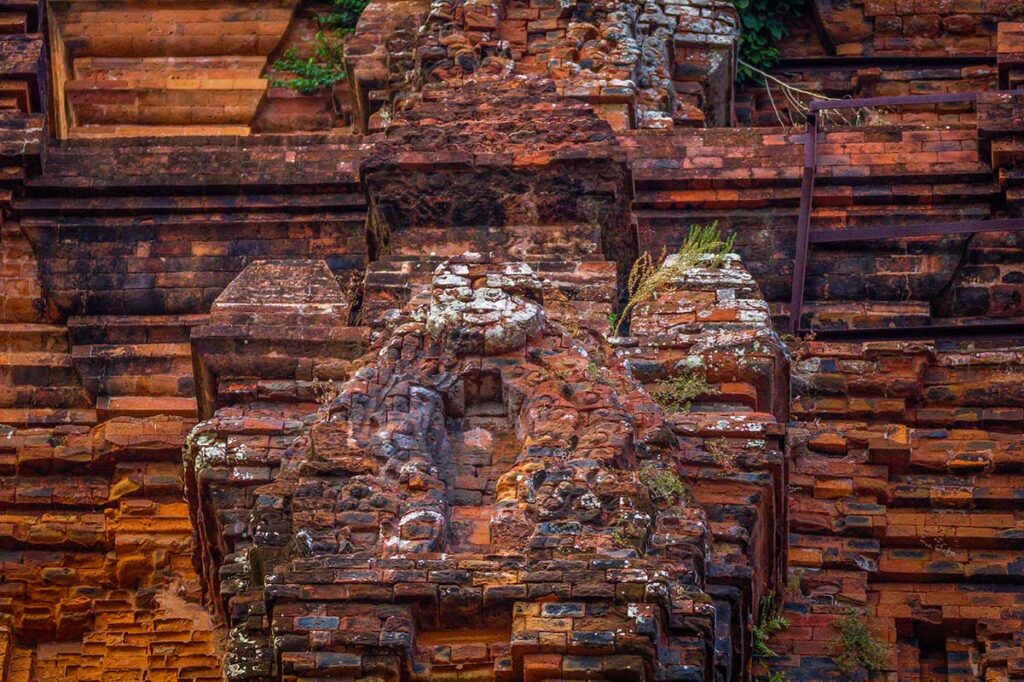
The bricks were joined with an adhesive made from the oleander tree, giving them unusual durability. Look closely at the details: lotus-bud corners, faint dragon carvings, and the stone linga at the top, symbolizing Shiva and fertility.
4. Inside the tower & Nearby features
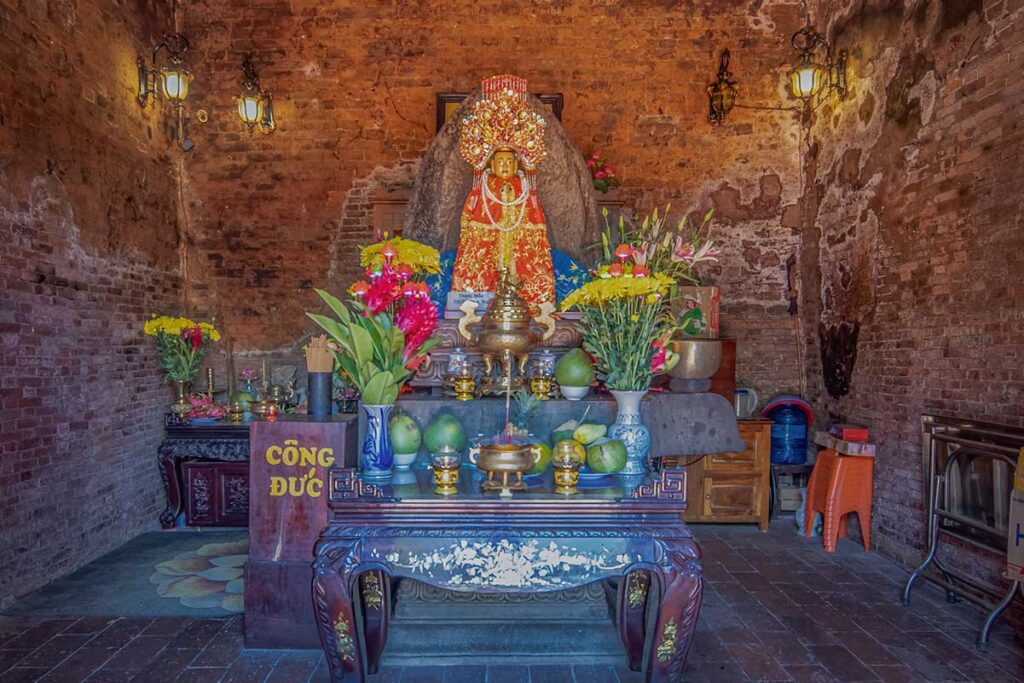
The interior of the tower is mostly empty today, but there is a small Later Lê–era temple inside where incense is still burned.
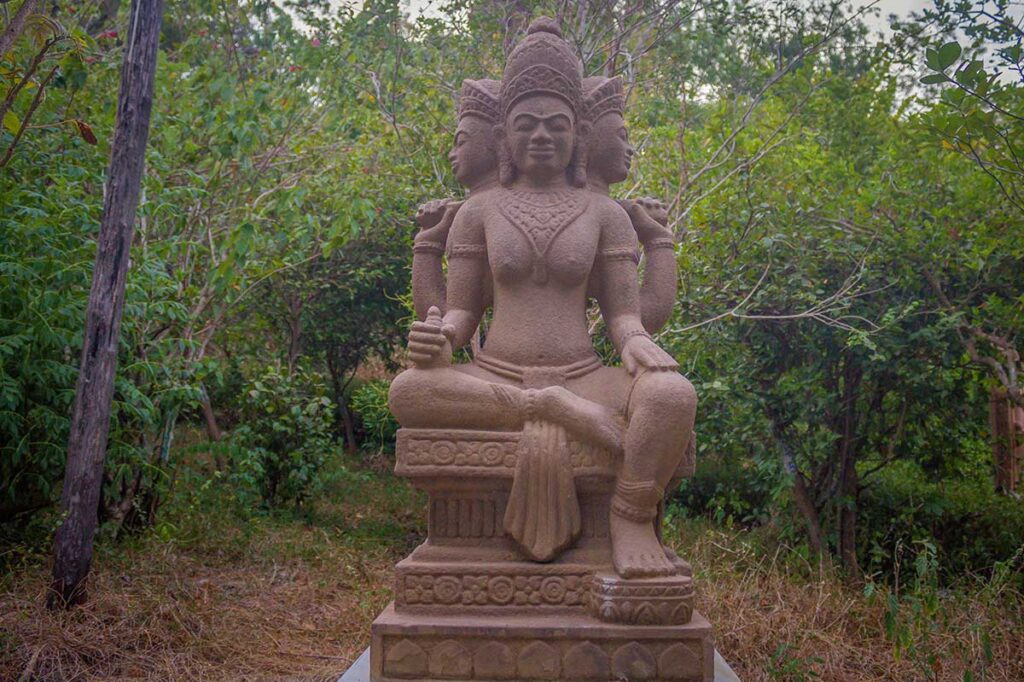
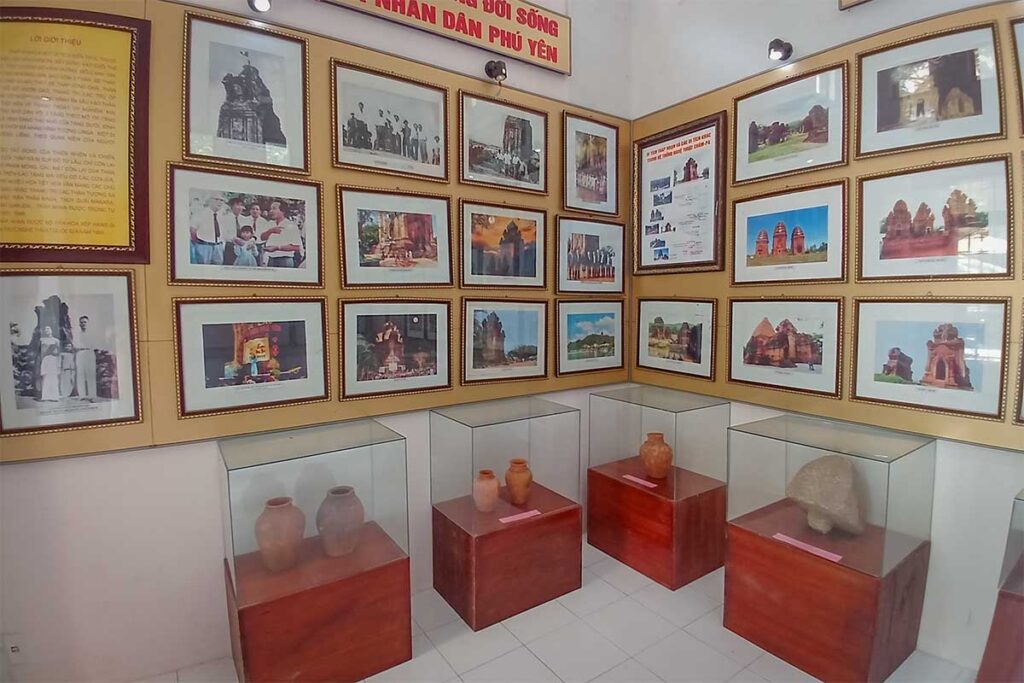
Around the lower levels you’ll also find a statue garden and a small exhibition room with displays about the site’s history. If you wander a little further, remnants of war-era bunkers still stand, a reminder of the hill’s strategic importance in the 20th century.
5. Relaxed atmosphere & Photography
One of the biggest appeals of Nhan Tower is its calm setting. Unlike busier Cham sites elsewhere, it rarely feels crowded, and the breezy hilltop gives you a chance to pause above the noise of the city. The tower is illuminated at night, creating a very different mood for photography compared to daytime. It’s as much a place to sit and take in the view as it is a monument to explore.
Festivals & Cultural events
Nhan Tower is also a gathering place for local cultural life. The most notable occasion is the Via Ba Festival in the third lunar month, when people honor the goddess Thien Y A Na with ceremonies and offerings. On the 1st and 15th days of the lunar calendar, locals also come here to light incense and pray. Another highlight is the Nguyen Tieu poetry night, held during the Lunar New Year period, where traditional verses are recited at the tower. Even if you don’t attend these events, it’s good to know the tower is more than just a relic—it remains a living part of community traditions.
Location & Getting there
Where is Nhan Tower?
Nhan Tower stands on Nhan Mountain in Ward 1, right in the heart of Tuy Hoa City, Phu Yen Province. The base city is Tuy Hoa, which is well connected with a small airport, a train station on the North–South railway, and long-distance buses. From anywhere in Tuy Hoa, the tower is only a short ride away.
Taxi or Ride-Hailing
If you’re staying in Tuy Hoa, the easiest way to get to Nhan Tower is by taxi or Grab. The ride takes just five to ten minutes from most hotels in the center, and it’s no problem to find a return ride once you’re done.
Car with Driver
If you’re exploring more of Phu Yen in a day, hiring a private car with a driver is a convenient option. This way you can stop at Nhan Tower along with coastal viewpoints, Cham sites, or beaches without worrying about parking or directions. The driver waits for you while you visit.
Renting a motorbike
Renting a motorbike is the cheapest and most flexible way to get around Tuy Hoa, including the short ride up to Nhan Tower. The road conditions are good and easy to handle, even for beginners. Officially you need an international driving permit (IDP) with your home license for insurance to be valid, though rental shops rarely ask for it.
Practical visiting information & Travel Tips
Entrance & Costs
Visiting Nhan Tower is free of charge, and the site is open roughly from 6:30 in the morning until 11:00 at night. There’s a small parking fee if you come with your own motorbike or car. If you don’t want to walk up the hill, you can also take an electric cart to the top for about 15,000 VND.
Best time to visit
The most pleasant times are early in the morning or late in the afternoon, when the sun is softer and the site is less busy. In the evening, the tower is lit up and the breezy hilltop makes it a cool place to linger. The dry season from January to August is the most comfortable overall, while the rainy months from September to December can make the steps slippery.
Time Needed
Most people spend between 30 and 60 minutes here, enough to walk up, explore the tower, and take in the views.
Facilities & Amenities
There are toilets and small stalls at the base of the hill where you can get water or snacks. On the lower levels, you’ll also find an exhibition room with displays about the site’s history. For meals or cafés, you’ll need to head back into Tuy Hoa, which is only a few minutes away.
What to bring
Wear comfortable walking shoes for the short climb, and bring water and sun protection if you’re visiting during the day. A camera or phone with a good battery is a must for the views, and a light jacket can be useful if you go in the evening when the breeze picks up.
Etiquette & Behavior
Dress modestly, as the tower is still considered a spiritual site. If you visit during a festival or on lunar calendar prayer days, give space to those worshipping and keep noise levels down. Avoid climbing on the tower or touching delicate carvings.
Safety & Caution
The stairs can be slippery after rain, so take care with your footing. At night, the winds at the top of the hill can be strong, so hold onto hats or loose items.
Is Nhan Tower worth visiting?
If you’re already in Tuy Hoa, Nhan Tower is definitely worth the short detour. The views from the hilltop are wide and refreshing, and the tower itself gives you a cultural touchpoint with Cham history and local legends.
That said, it’s not on the same scale as the Cham ruins in My Son or the more elaborate towers in Binh Dinh. Think of it as a peaceful, easy stop that combines history with atmosphere rather than a full-day destination. The relaxed setting above the city makes it a pleasant place to pause during your time in Phu Yen.
